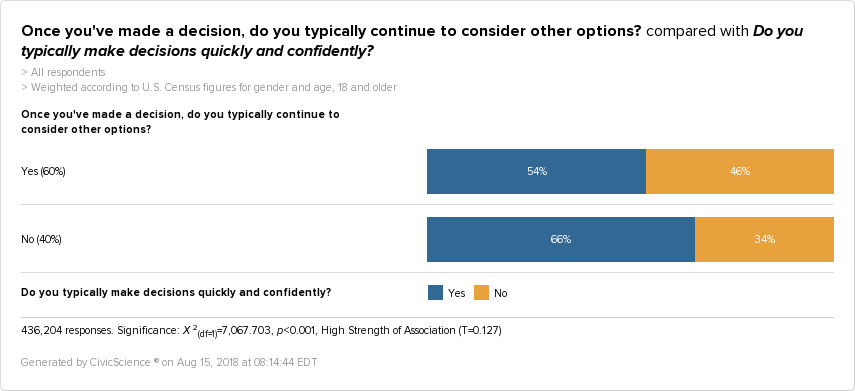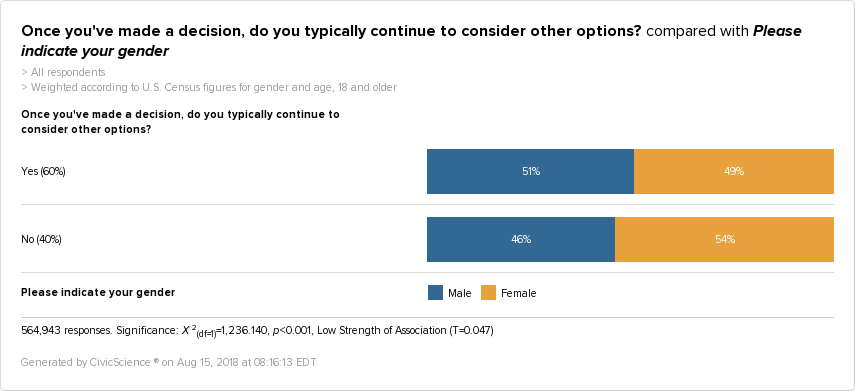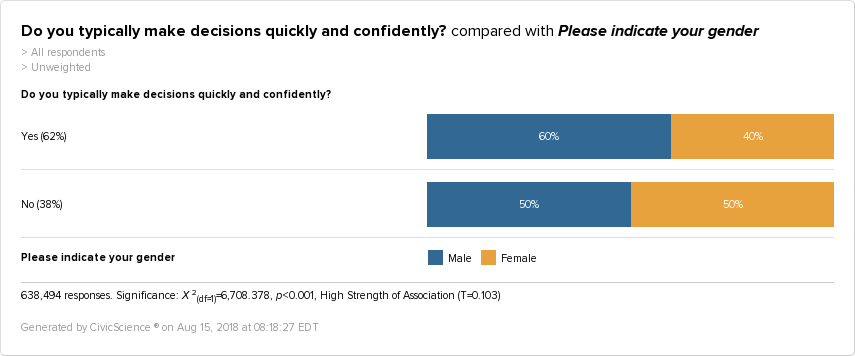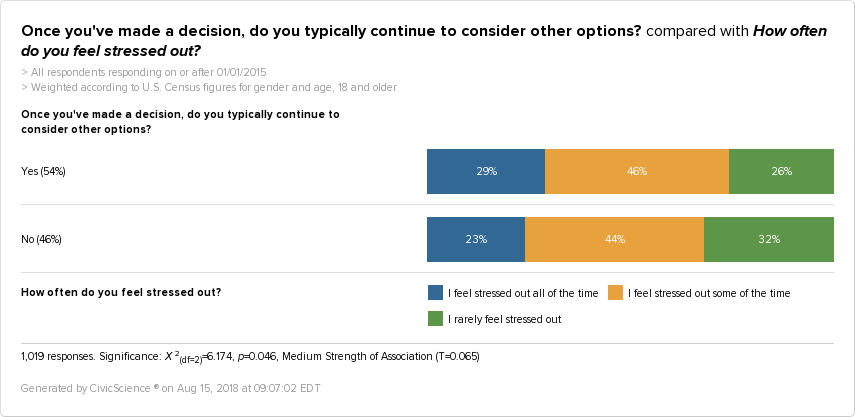FOBO, or “Fear of Better Options,” has recently captured the headlines, explaining why it is so difficult to make a decision. This new acronym comes on the heels of FOMO, or “Fear of Missing Out,” another 21st-century concern afflicting society in this highly digital and interconnected age.
CivicScience asked over 350,000 U.S. adults since January 1, 2015, about their decision-making process. At first glance, it appears that the majority of Americans do their best to steer clear of ambiguity.
57% of U.S. adults over the last three years indicated that when making decisions, they like to have things settled.
And when it comes to making these decisions, 58% report typically making decisions quickly and confidently.
Both of these statistics suggest that there is a nationwide preference for decisiveness and achievement. After all, making a decision implies a certain sense of freedom to move forward and prepare for the next. However, as further research reveals, the decision-making process may not be quite so linear.
60% of respondents typically continue to consider other options, even after making a decision.
This is a striking percentage of the population, especially as it goes in direct contrast to the previously established notion that adults in the U.S. are of a more decisive mindset. As it turns out, even people who are confident about their decisions report considering other options.
54% of U.S. adults who say they do make decisions quickly and confidently also report considering other options after making a decision.
These figures shed light on much larger questions regarding decision-making in the U.S. What is a confidently-made decision? What causes so many self-identified confident decision makers to demonstrate this after-the-fact insecurity with their choices? And, is there also an issue of self-perception at play, with some of the most confident decision makers masking their actual behavior with perceived confidence?
While the data may not answer these questions specifically, it does provide insight as to the demographics that are the most challenged when it comes to deciding without regret.
Although the gender gap is slight, it appears that 54% of those who do not consider other options after making a decision are women.
That said, women are much less likely to say they make decisions quickly and confidently, making up 40% of this group. 60% of those who are resolute when making a choice are men.
While women may not consider themselves quick and confident decision-makers, their slight lead in not re-thinking their decisions could indicate that slow and steady may lead to less second-guessing of the decision-making process, later on.
There may also be an age component at play. Millennials are far more likely to consider other options after making a decision, while Baby Boomers are more resolved in moving on after making a choice. Interestingly, Gen Xers are almost evenly split.
Does this mean that FOBO decreases with age? Are Millennials, who arguably spend the most amount of time online, more aware of the vastness of their options? Or does this fear of better choices reach a peak at a certain life stage, only to experience a sharp decline? It is certainly something to consider.
The data does, however, speak more clearly to the impact of income. As earnings increase, the experience of continuing to consider other options decreases.
Low-income earners have the greatest amount of FOBO, with 45% of respondents from this group rethinking their decisions. That percentage decreases to 32% of middle-income earners and 23% of high-income earners. Perhaps money does reassure some decision makers that they have exhausted all of their options. Conversely, having less money may put pressure on an individual to make sure each decision is right. There are countless factors that could cause this connection between rethinking decisions and income level, but whatever the cause, the correlation is clear.
Stress may also be a factor in confident decision-making, with 29% of those who continue to consider other options saying that they feel stressed out all of the time. On the other end of the scale, 32% of those who do not rehash a decision are rarely stressed out. That is a solid step up from the 26% of decision re-thinkers who feel the same.
Whether rehashing a decision causes stress or people who are stressed tend to spend more time second-guessing their decisions, the two clearly do exist side by side.
And, as the data reveals, addiction to digital devices may also play a role. 24% of those who do consider other options after making a decision also consider themselves addicted to their digital devices. In contrast, 28% of those who do not reconsider their choices also do not consider themselves digitally addicted.
Combined with the other factors such as gender, age, income, and stress, it seems that for many, making a decision is a murky and unpleasant experience.
In 2018, FOBO is alive and well. And while it’s an undeniably catchy acronym, its prevalence and relevance to so many U.S. adults cast a worrisome shadow over the state of mental health in the country.


















